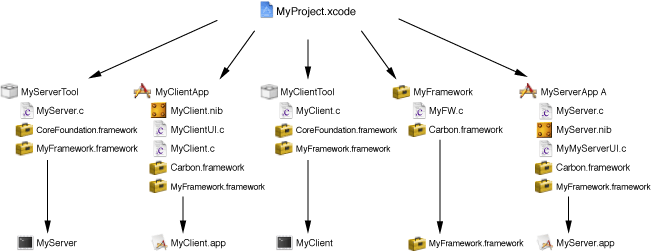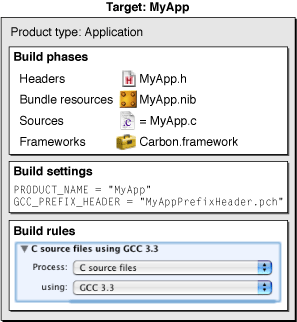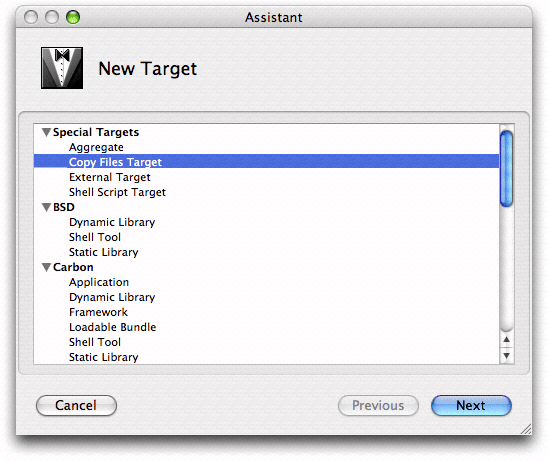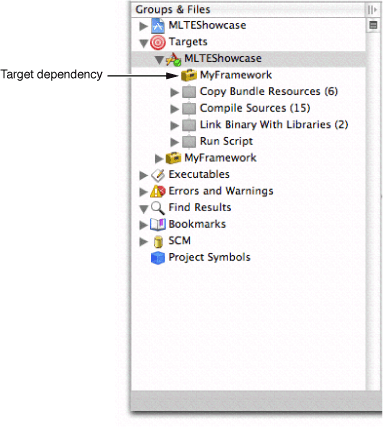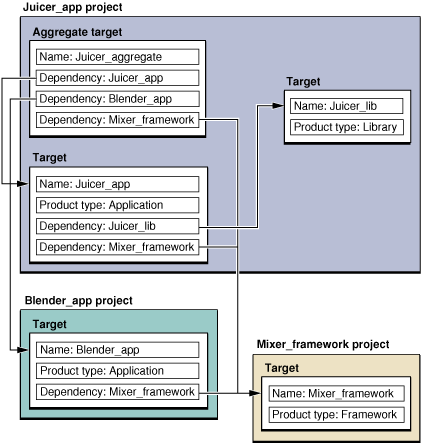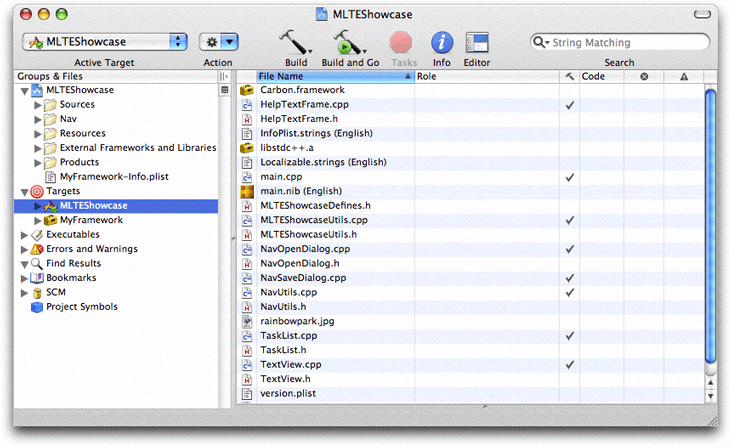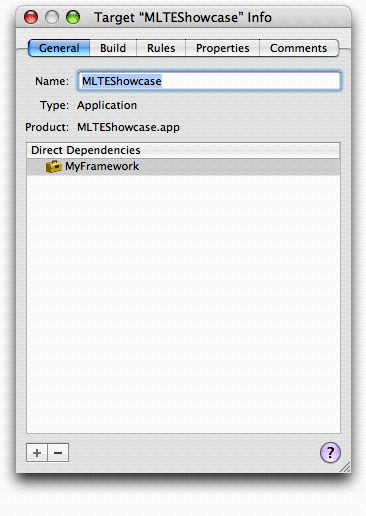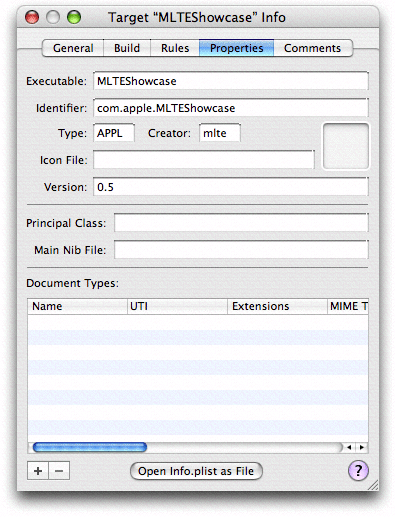Legacy Document
Important: The information in this document is obsolete and should not be used for new development.
Targets
The organizing principle of the Xcode build system is the target. A target contains the instructions for building a finished product from a set of files in your project. Some common types of products are frameworks, libraries, applications, and command-line tools. Each target builds a single product. A simple Xcode project has just one target, which produces one product from the project’s files. A larger development effort with multiple products may require a more complex project containing several related targets. For example, a project for a client-server software package may contain targets that create these products:
A client application
A server application
Command-line tool versions of the client and server functionality
A private framework that all the other targets use
Figure 23-1 shows the targets you may have in a project such as the one described above, and the products that those targets create.
When you initiate a build, Xcode builds the product specified by the current, or active, target and any targets on which the active target depends. In the Groups & Files list, the active target is marked by a checkmark in a round green circle. You can also see which target is active, as well as change the active target, in the Active Target pop-up menu in the project and Build Results windows, as described in “Building a Product.”
This chapter describes targets in Xcode and the information that they contain, and shows you how to create and modify targets.
In this section:
Anatomy of a Target
Creating Targets
Target Dependencies
Working with Files in a Target
Inspecting Targets
Converting a Project Builder Target
Anatomy of a Target
A target is a blueprint for creating a product; the target organizes the inputs to the build system process—the source files and the instructions for processing them—required to create that product. These inputs are:
Files. Each target contains a list of files that the build system takes as inputs and performs various operations on—such as compiling, linking, copying, and so forth—to arrive at the final product. Examples of source files are source code files, headers, resource files, and so forth.
Build phases. Build phases organize the source files of a target according to the operations required to build a target’s product. Each build phase consists of a list of input files and a task to be performed on each of those input files. Common build phases include compiling files, linking object files, and copying resource files.
Xcode populates each new target with a default set of build phases. You can add or remove build phases to change the operations performed by Xcode when building the target. For further details on build phases, see “Build Phases.”
Build settings. A build setting contains information on how to perform the operations required to build a product. For example, a build setting can specify command-line options for Xcode to pass to the compiler. Build settings can contain tool-specific options, paths to build files and product directories, and other information used by Xcode to determine how to perform build operations.
Each target contains a list of build settings. Although you will most likely make most of your build setting changes at the target level, build settings can be modified in a number of other locations, such as build styles, as well. By modifying build settings at these other layers, you can quickly make a change and apply it to multiple targets, conditionally change the way a product is built, and so forth.
Because build settings represent variable aspects of the build process, they are the most flexible means of customizing the build process. See “Build Settings” for more information on using build settings.
Build rules. A target’s build rules determine how each source file in the target is processed. Each build rule consists of a condition—such as files matching the type “.c”—and an action. Typically, this action specifies the tool Xcode should invoke to process files that meet the condition; this is how Xcode determines the compiler to use for compiling source files. Build rules apply only to the Compile Sources and Build ResourceManager Resources build phases. Xcode defines a default set of build rules, but you can define your own custom build rules for a target. For more information on using build rules, see “Build Rules.”
A target and the product that it creates are closely related; every target has an associated product type. When you create a new target from a target or project template, you choose the target’s product type, as described in “Creating a New Target.”
Based on the product type, Xcode specifies initial values
for certain product-specific build settings. For example, when you
create a target that builds an application, Xcode assigns it the
build setting specification INSTALL_PATH = "/Applications" based
on the product type. Any subsequent changes you make to the target
after creating it may override these default values. Note that the
project and target templates contain additional configuration information
that Xcode uses when it creates new targets.
Creating Targets
When you create a new project from one of the Xcode project templates, Xcode automatically creates a target for you. If, however, your project needs to contain more than one target—usually because you are creating more than one product—you can also add new targets to an existing project. This section shows you how to:
Create a new target.
Duplicate an existing target.
Remove unused targets from the project.
Creating a New Target
If you are adding new targets to your project, chances are you’ve already made a number of decisions about product type, programming language, and framework. Xcode provides a number of target templates to support your choices. The selection of target templates is similar to the selection of project templates. The target specifies the target’s product type, a list of default build phases, and default specifications for some build settings. A target template typically includes all build settings and build phases required to build a basic instance of the specified product. Unlike the project templates provided by Xcode, the target templates do not specify any default files; you must add files to the target yourself, as described in “Working with Files in a Target.”
You can create a new target and add it to an existing project in either of the following ways:
Choose Project > New Target.
Control-click in the Groups & Files list and choose Add > New Target from the contextual menu.
Xcode presents you with the New Target Assistant, shown here, which lets you choose from a number of possible target templates. Each target template corresponds to a particular type of product, such as an application or loadable bundle. Select one of these templates and click Next. Enter the name of the target; if more than one project is open, you can choose which project to add the new target to from the Add to Project menu. When you click Finish, Xcode creates a new target configured for the specified product type. Xcode also creates a reference to the target’s product and places it in your project, although the product does not exist on disk until you build the target.
Xcode provides the target templates listed in the following tables. Table 23-1 lists templates that create targets using Xcode’s native build system. Because it performs all target and file-level dependency analysis for targets using the native build system, Xcode can offer detailed feedback about the build process and integration with the user interface for these targets.
Target template |
Creates |
|---|---|
BSD |
|
Dynamic Library |
A dynamic library, written in C, that makes use of BSD. |
Shell Tool |
A command-line utility, written in C. |
Static Library |
A static library, written in C, that makes use of BSD. |
Carbon |
|
Application |
An application, written in C or C++, that links against the Carbon framework. |
Dynamic Library |
A dynamic library that links against the Carbon framework. |
Framework |
A framework based on the Carbon framework. |
Loadable Bundle |
A bundle, such as a plug-in, that can be loaded into a running program. |
Shell Tool |
A command-line utility based on the Carbon framework. |
Static Library |
A static library, written in C or C++, based on the Carbon framework. |
Cocoa |
|
Application |
An application, written in Objective-C or Objective-C++, that links against the Cocoa framework. |
Dynamic Library |
A dynamic library that links against the Cocoa framework. |
Framework |
A framework based on the Cocoa framework. |
Loadable Bundle |
A bundle, such as a plug-in, that can be loaded into a running program. |
Shell Tool |
A command-line utility based on the Cocoa framework. |
Static Library |
A static library, written in Objective-C or Objective-C++, based on the Cocoa framework. |
Java |
|
Application |
An application, written in Java, and packaged as an application bundle. |
Applet |
A Java applet, built as a JAR file. |
Tool |
A command-line utility, written in Java and built as a JAR file. |
Kernel Extension |
|
Generic Kernel Extension |
A kernel extension |
IOKit Driver |
A device driver that uses the I/O Kit. |
Xcode also supports targets that use Project Builder’s Jam-based build system. Table 23-2 lists the templates that create targets using the Project Builder build system, called legacy targets. Note that Jam-based targets are supported only for compatibility with existing Project Builder projects. Where possible, you should use native targets instead. Legacy targets are discussed further in “Converting a Project Builder Target.”
Template |
Creates |
|---|---|
Application |
An application bundle. |
Bundle |
A standard bundle. |
Cocoa |
|
Application |
An application, written in Objective-C or Objective-C++, that links against the Cocoa framework |
Framework |
A framework. |
Java |
|
Application |
An application, written in Java, and packaged as an application bundle. |
Applet |
A Java applet, built as a JAR file. |
Package |
|
Tool |
A command-line utility, written in Java and built as a JAR file. |
Kernel Extension |
|
Generic Kernel Extension |
A kernel extension |
IOKit Driver |
A device driver that uses the I/O Kit. |
Library |
A dynamic or static library |
Tool |
A command-line utility. |
In addition to the target templates described above, Xcode defines a handful of target templates that do not necessarily correspond to a particular product type. These targets are described in the next section.
Special Types of Targets
Xcode defines a handful of target templates that do not necessarily correspond to a particular product type. Instead, these targets can be used to:
Build a group of targets together
Build a product using an external build system
Run a shell script
Copy files to a specific location in the filesystem
Aggregate
Xcode defines a special type of target that lets you build a group of targets at once, even if those targets do not depend on each other. An aggregate target does not have an associated product and it does not contain build information, such as build rules. An aggregate target depends on each of the targets you want to build together. For example, you may have a suite of applications and want to build them at once for a final build. You would create an aggregate target and make it depend on each of the individual application targets; to build the entire application suite, just build the aggregate target.
An aggregate target may contain a custom Run Script build phase or a Copy Files build phase, but it does not contain any other build phases.
External
Xcode allows you to create targets that do not use Xcode’s
own native build system but instead use an external build tool that
you specify. For example, if you have an existing project with a
makefile, you can use an external target to run make and
build the product.
An external target creates a product but does not contain
build phases. Instead, it calls a build tool in a directory. With
an external target, you can take full advantage of Xcode’s editor,
class browser, and source-level debugger. However, many Xcode features—such
as ZeroLink and Fix and Continue—rely on the build information
maintained by Xcode for targets using the native build system. As
a result, these are not available to an external target. Furthermore,
you must maintain your custom build system yourself. For instance, if
you need to add files to an external target built using make,
you must edit the makefile yourself.
Shell Script
A Shell Script target is an aggregate target that contains only one build phase, a Run Script build phase. Building a Shell Script target simply runs the associated shell script. Shell Script targets are useful if you have custom build steps that need to be performed. While Run Script build phases allow you to add custom steps to the build process for a single target, a Shell Script target lets you define a custom build operation that you can use with many different targets. For example, if your project has several targets that each use the files generated by a Shell Script target, you can make each of those targets depend upon the Shell Script target.
Copy Files
A Copy Files target is an aggregate target that contains only one build phase, a Copy Files build phase. Building a Copy Files target simply copies the associated files to the specified destination in the filesystem. Copy Files targets are useful if you have custom build steps that require files that are not specific to any other targets to be copied. While Copy Files build phases allow you to add a step to the build process for a single target that copies files in that target, a Copy Files target lets you copy files that are not specific to any one target. For example, if your project has several targets that require the same files to be installed at a particular location, you can use a Copy Files target to copy the files, and make each of the other targets depend upon the Copy Files target.
Duplicating a Target
There are a number of reasons why you might need to duplicate a target: you require two targets that are very similar but contain slight differences in the files or build phases that they include, or you have a complicated set of options that you build with and would prefer to simply start with a copy of a target that already contains those build settings.
Xcode allows you to duplicate a target, creating a copy that contains all of the same files, build phases, dependencies and build settings. You can create a copy of a target in the following way:
In the Groups & Files list, select the target you which to copy.
Choose Edit > Duplicate or Control-click and choose Duplicate from the contextual menu.
Removing a Target
If your project contains targets that are no longer in use, you can remove them from the project in the following ways:
Select the target to delete in the Groups & Files list.
Press the Delete key or choose Edit > Delete.
When you delete a target, Xcode also deletes the product reference for the product created by that target and removes any dependencies on the deleted target.
Target Dependencies
In a complex project, you may have several targets that create a number of related products. Frequently, these targets need to be built in a specified order. Returning to the example of the client-server software package created by the project shown in Figure 23-1, you’ll see that the client application, server application, and command-line tool targets each link to the private framework created by another target in the same project.
Before the application and command-line tool targets can be built, the framework target must be built. Because they require the private framework in order to build, each of the application and command-line tool targets is said to depend upon the target that creates the framework. You can use a target dependency to ensure that Xcode builds targets in the proper order; in this example, you would add a dependency upon the framework target to each of the application and command-line tool targets.
However, the applications and command-line tool in the client-server package must still be built individually. None of these targets requires the product created by any target other than the framework target. Xcode provides another mechanism for grouping targets that you want to build together, but that are otherwise unrelated; this is an aggregate target. The following sections show you how to add a target dependency and create an aggregate target, and gives an example of how you can use these tools to organize a software development effort with multiple products and projects.
Adding a Target Dependency
When you build a target with a dependency upon another target, Xcode makes sure that this other target is built and up-to-date before building the active target. That way, you can guarantee that when target A needs the product created by target B, target B is built before target A. In addition, if there are errors building target B, Xcode doesn’t build target A.
You can view and modify a target’s dependencies:
In the General pane of the target inspector. The Direct Dependencies list in the bottom half of the General pane shows the other targets upon which the current target depends.
To add a target dependency, click the plus sign button and select the target upon which you want the current target to depend in the resulting dialog. The list of targets includes all of the other targets in the current project, as well as the targets in any referenced projects. Targets in referenced projects are grouped according to the project to which they belong; click the disclosure triangle next to the project icon to see the targets in that project. For more information on referencing other projects, see “Referencing Other Projects.”
To remove a target dependency, select it in the list and click the minus button.
In the Groups & Files list. Click the disclosure triangle next to the target; the targets that the current target depends on are listed before the build phases in the target. You can make the current target depend on another target by dragging that target to the current target in the Groups & Files list. To delete a target dependency, select it in the Groups & Files list and press Delete or choose Edit > Delete. Figure 23-4 shows a target dependency in the Groups & Files list.
Creating an Aggregate Target
To build several related targets at the same time, even if they aren’t dependent on each other, create an aggregate target. As described in “Special Types of Targets,” an aggregate target does not produce a product itself and it does not contain build rules or information property list entries. Instead it exists so that you can make it dependent on other targets. To build a group of related targets, just build the aggregate target.
To create an aggregate target, choose Project > New Target and select Aggregate from the New Target Assistant. For each target you want to build with this aggregate target, add a target dependency to the aggregate target, as described in the “Adding a Target Dependency.”
Note that, while it does not contain any other build phases, an aggregate target can include a Run Script or Copy Files build phase.
An Example With Multiple Targets and Projects
Suppose that your company has two teams working on separate applications, that one application includes an internal library, and that each application relies on a framework supplied by a third team. Figure 23-5 shows one way to set up your software development with three Xcode projects, using target dependencies, aggregate targets, and cross-project dependencies to relate the various products.
In Figure 23-5, the Juicer_app project
contains the Juicer_app target,
for building the Juicer application, and the Juicer_lib target,
for building an internal library. The application target depends
on the library target, and also has a cross-project dependency on
the Mixer_framework target
in the Mixer_framework project.
Finally, the Juicer_app project
contains the Juicer_aggregate target,
as a convenience for building the entire suite of projects.
Note: Aggregate targets are typically used to build targets that don’t otherwise depend on each other.
In Figure 23-5, the Blender_app project
contains a target for building the Blender application. The Blender
target also has a cross-project dependency on the Mixer framework.
Finally, the Mixer_framework project
contains a target for building the Mixer framework, used by both
the Juicer and Blender applications.
Given this combination of projects, targets, and dependencies, the following statements are true:
Building the Juicer target builds the Juicer library, if it needs updating, and also builds the Mixer framework, if it needs updating.
Building the Juicer aggregate target builds the Juicer application, which builds the Juicer library, if it needs updating. The aggregate target also builds the Blender application and the Mixer framework.
Building the Juicer library does not cause any other targets to be built.
Building the Blender target builds the Mixer framework, if it needs updating.
Working with Files in a Target
When you add files to a project, you can have Xcode also add those files to one or more targets. When you add files to a target in this way, Xcode automatically assigns them to the appropriate build phase, based on the file’s type. This is the easiest way to add files to a target. However, you may have existing files in your project that you wish to add to a target, or find that you no longer need a target file. This section describes how to view the files in a target and shows you how to add and remove target files.
Viewing the Files in a Target
To view all of the files included in a target, select the target in the Groups & Files list; all targets are organized into the Targets smart group. The detail view shows all of the files and folders in the target, similar to what you see in the following figure. If one is not already open in the current window, open a detail view by choosing View > Detail.
You can also see a target’s files grouped according to the operation performed on those files during the build process. If you click the disclosure triangle next to a target, you will see the build phases for that target. Build phases, described in further detail in “Build Phases,” represent a task performed when the target is built. To see the files in a particular build phase, click the disclosure triangle next to the build phase or select the build phase and open a detail view.
Adding and Removing Target Files
You can change which files are included in a target from the project window. To add files to a target, you can:
Drag the file reference or references to the appropriate build phase of the given target in the Groups & Files list. For native targets, Xcode does not let you drag a file to a build phase that does not accept that type of file as an input. For example, you cannot drag a NIB file to the Compile Sources build phase. See “Build Phases” for more information on the available build phases and their files.
Specify that a file be included in a target when you add that file to your project, as described in “Adding Files, Frameworks, and Folders to a Project.”
To add a file to the active target, find the file in the detail view or in the Groups & Files list and select the checkbox in the Target column for that file. If the Target column is not visible, choose View > Detail View Columns > Target or View > Groups & Files Columns > Target.
To remove a file from a target, do the following in the Groups & Files list:
Click the disclosure triangle next to the target to reveal the target’s build phases.
Click the disclosure next to the build phase to which the file belongs.
Select the file to remove from the target and click Delete or choose Edit > Delete.
To remove a file from the active target, find the file in the detail view or in the Groups & Files list and deselect the checkbox in the Target column for that file. Xcode removes the file from the target, but does not remove the file reference from the project.
Inspecting Targets
Like most other project items, targets have inspector and Info windows that allow you to view and modify target settings. As previously described in “Anatomy of a Target,” a target defines the instructions necessary to create a product. Each target has an associated set of files, tasks and settings that together constitute these instructions. You can edit and inspect many of these settings in the target inspector.
Note: To learn how to modify the files and build phases associated with a target, see “Working with Files in a Target” and “Build Phases,” respectively.
The information available in the inspector window varies, depending on the type of target. The inspector window for native targets lets you view and edit all target settings and build information associated with that target. The inspector window for legacy and external targets contains only general information. To edit build information for either of these types of targets, you must use the target editor.
Inspecting Native Targets
The inspector window is the primary means of viewing and editing the information in native targets. Figure 23-7 shows the inspector window for a native target.
This window contains the following panes:
The General pane contains general information about a target, such as its name, the name of the associated product, and target dependencies. The General pane is described in “Editing General Target Settings.”
The Build pane lets you view and edit build settings for the target. The Build pane is described in “Editing Build Settings in the Xcode Application.”
The Rules pane displays the current system build rules, as well as any custom build rules defined for the current target. The Rules pane is described in “Build Rules.”
The Properties pane lets you edit information property list entries for targets that create products requiring Info.plist files, such as applications and other bundles. If the target does not have an Info.plist file, this pane is not visible in the inspector. This pane is described in “Editing Information Property List Entries.”
Comments. The Comments pane lets you associate notes or other documentation with the target. See “Adding Comments to Project Items” for more information.
Inspecting Legacy and External Targets
You can view and edit only general target information in the inspector window for Jam-based Project Builder targets and external targets. You cannot configure build information for these targets. The inspector window for legacy and external targets contains the following panes:
The General pane contains general information about a target, such as its name, the name of the associated product, and target dependencies. The General pane is described in “Editing General Target Settings.”
Comments. The Comments pane lets you associate notes or other documentation with the target. See “Adding Comments to Project Items” for more information.
If you have an existing Project Builder project with a Jam-based target, you can convert your target to use the Xcode native build system to edit build settings or build rules for the target in an inspector or Info window.
To edit the build settings for Jam-based and external targets in Xcode, use the target editor, described in “Editing Build Settings for Legacy and External Targets.”
Editing General Target Settings
In the General pane of the target inspector, you can edit basic target settings for any target in Xcode. The General pane contains the following settings:
Name. This is the name Xcode uses to refer to the target. To rename the target, click in the text field and type the new name.
Type. This is type of product created by the target. The product type is determined when you create the target; you cannot change it.
Product. The name of the product created from the target; for example, “MyApp.app.” The Product Name (PRODUCT_NAME) build setting specifies the product name, excluding any extension; in this example, “MyApp.”By default, this is the same as the target name. To change the name of the product, you can change the name of the target or customize the Product Name build setting.
To change the product extension—in this case, “app”—change the value of the Wrapper Extension (WRAPPER_EXTENSION) build setting.
Dependencies. A list of the targets upon which the current target depends. See “Adding a Target Dependency.”
Editing Information Property List Entries
Information property list entries contain information used
by the Finder and system software. This information ends up in a
file called Info.plist that’s
contained within the product’s bundle. If a product does not come
in the form of a bundle, it has no Info.plist file.
The Info.plist file
tells the Finder what the bundle’s icon is, what documents it
can open, what URLs it can handle, and so on. Unlike build settings,
property list entries do not affect the build process but are simply
copied directly into the bundle’s Info.plist file
at the end of the build process. For a list of entries used by the
system and Finder, see Runtime Configuration Guidelines.
For Native Targets
The Properties pane of the target inspector, shown below, allows you to edit information property list entries for native targets. This pane is only visible for targets that create products with Info.plist files.
The top section of the pane allows you to edit basic information about the product, such as the name of the associated executable, the identifier, type and creator, version information, and an icon to associate with the finished product. Note that the name of the icon here must match the name of an icon file that is copied into the Resources folder of the product bundle.
The Principal Class and Main Nib File options are specific
to Cocoa applications and bundles. The Principal Class corresponds
to NSPrincipalClass.
The Main Nib File field specifies the nib file that’s automatically
loaded when the application is launched. It corresponds to the information
property list key NSMainNibFile.
The Document Types table allows you to specify which documents your finished product can handle. You can add and remove document types from this list using the plus and minus buttons. Here is what’s in the Document Types table:
Name is the name of the document type. For example, “Apple Sketch Document.”
Class is the subclass of NSDocument that this document uses. Use this field only if you’re writing a document-based Cocoa application.
Extensions contains a list of the filename extensions for this document type. Don’t include the period in the extension. For example, “sketch” and “draw2”.
UTI contains a list of Uniform Type Identifiers (or UTIs) for the document. UTIs are strings that uniquely identify abstract types. They can be used to describe a file format or data type, but can also be used to describe type information for other sorts of entities, such as directories, volumes, or packages. For more information on UTIs, see the header file
UTType.h, available as part of LaunchServices.framework in Mac OS X v. 10.3 and later.MIME Types contains a list of the MIME types for the document.
OS Types contains a list of four-letter codes for the document. These codes are stored in the documents’ resources or information property list files. For example, “sktc”.
Icon File is the name of the file that contains the document type’s icon.
Role describes how the application uses the documents of this type. You can choose from three values:
Editor means this application can display, edit, and save documents of this type.
Viewer means this application can display, but not edit, documents of this type.
None means this application can neither display nor edit documents of this type but instead uses them in some other way. For example, the Finder could declare an icon for font documents.
Package specifies whether the document is a single file or a file package.
To edit a document type, click the type’s line in the Document Types list and edit the document type information.
You may have additional keys that you need to include in your Info.plist file;
for example, applications that include Apple Help help books need
two additional Info.plist entries.
To add these additional keys, you can edit the Info.plist file
directly, by clicking the Open Info.plist as File button at the
bottom of the Properties pane. You can refer to build settings in
the Info.plist file.
For example, $(PRODUCT_NAME) expands
to the base name of the product built by the target.
You can set properties on multiple targets; simply select the targets in the project window and open an Info or inspector window. In the Properties pane, you can edit the values of properties that apply to more than one target.
For Legacy Targets
You cannot configure Info.plist entries for Jam-based Project Builder targets in the target inspector. To edit the Info.plist entries for Jam-based targets in Xcode, select the target in the Groups & Files list. If you have an editor open in the project window, Xcode displays the Project Builder target editor. To view this target editor in a separate window, double-click the target. Select Info.plist Entries in the left side of the target editor; Xcode displays the target’s Info.plist entries in the target editor.
Converting a Project Builder Target
Xcode supports existing Project Builder targets that use the
Project Builder build system, based on the Jam software build tool.
Based on the information it maintains for a Jam-based target—build
phases and build settings—Xcode creates a text-based Jamfile for
the target and then invokes the jam command
to perform the build. You can continue to use your existing Project
Builder targets, or even create new Jam-based targets.
Although Xcode recognizes and can build Project Builder targets using the Jam-based build system, there are many advantages to converting to “native” targets that use Xcode’s native build system. One advantage is shorter build times, particularly for incremental builds. In addition, many of the new Xcode features—such as ZeroLink, and Fix and Continue—work only with native targets.
Xcode’s native build system performs its own dependency analysis and directly invokes the necessary build commands. The native build system takes advantage of the detailed information that the Xcode application maintains about a project’s targets and relationships to provide finer control over the build process and better feedback from the build system than you can obtain from using an external tool.
To convert all Jam-based targets in your project to the native build system, choose Project > Upgrade All Targets in Project to Native.
To upgrade a single target to use the native build system, select that target in the Groups & Files list and choose Project > Upgrade target name to Native.
Xcode creates a new copy of each target, configures it to create the appropriate product type, and adds it to the Targets group. Your existing Jam-based targets remain unchanged. Xcode preserves all target dependencies when upgrading targets to the native build system.
Xcode generates a log file that shows you the results of the upgrade to native targets. The information in this log file includes the product type created by the upgraded target, locations of common support files—such as Info.plist files, and changes made to any build settings.
© 2004, 2006 Apple Computer, Inc. All Rights Reserved. (Last updated: 2006-11-07)
